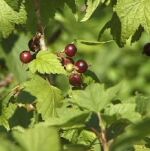| Common Name: |
Quinsy Berry |
| Other Names: |
Blackcurrant |
| Botanical Name: |
Ribes nigrum |
| Genus: |
Ribes |
| Family: |
Grossulariaceae |
| Cultivation: |
Well-drained, fertile, preferably clay soil in sun or partial shade, with protection from cold winds and late frosts. Remove weak growths and one third of older (gray or black) shoots in autumn. Bushes tend to lose vigor with age and are usually replaced every ten years or so. Buds may be damaged by birds, aphids, and blackcurrant ("big bud") gall mites. |
| Propagation: |
By hardwood cuttings in winter. |
| Harvest: |
Leaves are gathered during the growing season and used fresh, or dried for use in infusions; essential oil is extracted from buds. Fruits are picked when ripe; fixed oil is extracted from ripe seeds. |
| Native Region: |
Europe to C Asia, Himalayas. |
| Height: |
2m (6ft) |
| Width: |
2m (6ft) |
| Varieties: |
Ben Sarek
Is a compact, very high yielding, mid-season variety, producing large, high quality fruits. |
Ben Tirran
Produces large, well-flavored fruits that ripen late; high yielding and disease resistant. |
Goliath
Is upright, with very large, superbly flavored berries; mid-season.
Originated before 1847 |
|
| Hardiness: |
Z3-9 |
| Parts Used: |
Leaves, fruits, seeds, buds |
| Properties: |
A sweet-sour, astringent, tonic herb that reduces inflammation, strengthens capillaries, and controls bacterial infections. |
| Medicinal Uses: |
Internally for colds, capillary fragility, and mouth and throat infections. Externally for sore throat. |
| Culinary Uses: |
Fruits are eaten raw or cooked, and made into jams, jellies, syrup and cordials; also used to flavor wine vinegar. Dried leaves are used to make tea. |
| Economic Uses: |
Fruit extracts are used in herb teas, and to make liqueur, known as crème de cassis. Fixed oil is used in cosmetics and food supplements; pungent, musky essential oil, known as cassis, is used in perfumery. Dried leaves are used in blended herb teas. |
| Bibliography: |
Encyclopedia of Herbs by Deni Brown Copyright © 1995, 2001 Dorling Kindersley Limited. pp 344-345.
|

